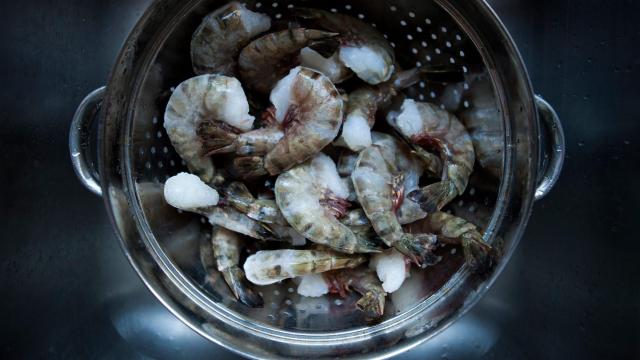I almost always have a couple of bags of frozen prawns in my freezer, but a couple of weekends ago I decided to grab some “fresh” ones from the seafood counter at the grocery store, hoping to shave off the 15 minutes it usually takes to defrost the little guys from my meal prep. I got home and made a prawn cocktail, and noticed the prawns were a little bit softer than what I am accustomed to. My boyfriend and I ate them anyway. Six hours later, he was puking. (I was fine.)
“Fresh” really means “thawed”
It should not have taken witnessing the pain of a loved one to reinforce what I already knew — frozen prawns are, almost always, fresher than the “fresh” stuff you see at the seafood counter. In fact, if you look on the little placards that sit in front of the piles of curled crustaceans, you’ll probably find an indication they were “previously frozen.” The store just took the liberty of thawing them for you.
Unless you are buying prawns from someone who just caught them, your prawns have (or should have) been frozen. This is a good thing. After a prawn is killed, the enzymes that digest the little prawn’s food start to break down the little body, rendering it soft and mushy. Freezing them not only halts this attack, it slows bacterial growth, ensuring the prawn that make it into your stomach are firm, flavorful, and as fresh as possible. Once they’re thawed, both the enzymes and bacteria start to do their thing once again, which is why it’s always safest — and tastiest — to buy frozen and thaw just before cooking and eating.
What about sodium tripolyphosphate and sodium bisulfite?
When you read the ingredients on bag of frozen prawn, you might find either or both of these ingredients on the label, especially if it’s a particularly cost-effective bag. According to Melissa Clark of the New York Times, sodium bisulfite is added to frozen prawns for aesthetic reasons:
Sodium bisulfite is used to keep prawn shells from undergoing melanosis (also called black spot), which is a darkening of the head and shell after the shrimp are harvested and exposed to oxygen. This reaction is harmless — think of it as the marine equivalent to the browning of apple flesh after you cut it.
The chemical isn’t harmful, but it also doesn’t prevent the prawn from deteriorating, protect it from bacterial growth, or preserve its flavour. It just keeps it looking nice and pink.
Sodium tripolyphosphate, on the other hand, is a chemical that causes seafood (such as shrimp and scallops) to absorb water, which Clark says can increase its weight by as much 1o per cent — and you end up paying for that extra bit of aqueous mass. It can also affect prawn’s cooked texture. Depending on how much water your prawns absorb, you can accidentally end up steaming them, rather than searing or sautéing, giving them a bouncy, rubbery feel. Luckily, if the prawns have been treated with either of those chemicals, they legally have to be listed on the packaging. Also, sodium tripolyphosphate is usually added after the shells have been removed, so look for shell-on prawns if you wish to avoid it, and save the tails for a tasty stock. It might cost you a little more to seek out frozen prawns that aren’t processed with these additives, but you’ll be putting your money toward tasty, fresh prawn meat that won’t feel weird in your mouth (or make you — or your boyfriend — sick).

Leave a Reply
You must be logged in to post a comment.